prehistoric
-

One of the larger stones of the Nine Maidens stone circle
Recharge your batteries with a walk out along the lane at Lower Bosullow past Men Scrifa and Men an Tol, and then up the hill in view of Carn Galver, Hannibal's Carn and the Little Galver to Nine Maidens. There is something wild, elemental and primitive about the landcape here apart from these...- trepolpen
- Media item
- nine_maidens prehistoric stone_circle
- Comments: 2
- Album: PENWITH VOLUME ONE: ROMANTIC, ANCIENT WEST CORNWALL
-

Men Scryfa and Carn Galver
This 'Men Skrifa' or 'Stone [of] Incription' bears one of names of the first Cornish people we know of: 'Rialobrani Cunovali Fili', a Latin inscription showing this to be the monument of Rialobran, son of Cunoval. There is another like this at Bleu Bridge, Gulval. These are probably chieftains...- trepolpen
- Media item
- bosullow carn_galva lower men_scryfa penwith prehistoric
- Comments: 0
- Album: PENWITH VOLUME ONE: ROMANTIC, ANCIENT WEST CORNWALL
-
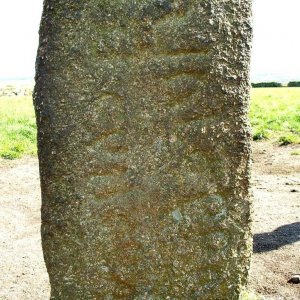
Men Scryfa
This 'Men Skrifa' or 'Stone [of] Incription' bears one of names of the first Cornish people we know of: 'Rialobrani Cunovali Fili', a Latin inscription showing this to be the monument of Rialobran, son of Cunoval. There is another like this at Bleu Bridge, Gulval. These are probably chieftains...- trepolpen
- Media item
- bosullow lower men_scryfa penwith prehistoric
- Comments: 0
- Album: PENWITH VOLUME ONE: ROMANTIC, ANCIENT WEST CORNWALL
-
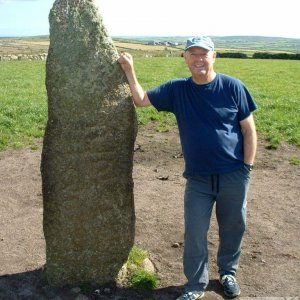
Men Scrifa - from about 500 AD
This 'Men Skrifa' or 'Stone [of] Incription' bears one of names of the first Cornish people we know of: 'Rialobrani Cunovali Fili', a Latin inscription showing this to be the monument of Rialobran, son of Cunoval. There is another like this at Bleu Bridge, Gulval. These are probably chieftains...- trepolpen
- Media item
- bosullow lower men_scryfa penwith prehistoric
- Comments: 6
- Album: PENWITH VOLUME ONE: ROMANTIC, ANCIENT WEST CORNWALL
-
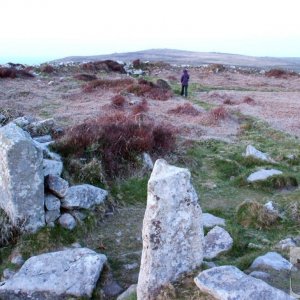
Chun Castle ramparts
Like Lescudjack Castle (which was bigger) and Trencrom (smaller), Chun Castle is a hilltop fortress dating from about 500 BC. It has two stone walls and ditches encircle the summit of the hill. The entrances are staggered to make it harder for the enemy to enter. 'Chun' is a Cornish name derived...- trepolpen
- Media item
- chun_castle penwith prehistoric
- Comments: 1
- Album: PENWITH VOLUME ONE: ROMANTIC, ANCIENT WEST CORNWALL
-
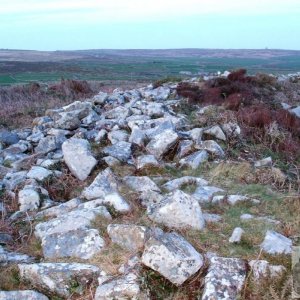
Chun Castle circular inner wall
Like Lescudjack Castle (which was bigger) and Trencrom (smaller), Chun Castle is a hilltop fortress dating from about 500 BC. It has two stone walls and ditches encircle the summit of the hill. The entrances are staggered to make it harder for the enemy to enter. 'Chun' is a Cornish name derived...- trepolpen
- Media item
- chun_castle penwith prehistoric
- Comments: 0
- Album: PENWITH VOLUME ONE: ROMANTIC, ANCIENT WEST CORNWALL
-
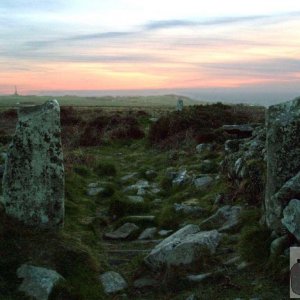
Chun Castle entrance
Like Lescudjack Castle (which was bigger) and Trencrom (smaller), Chun Castle is a hilltop fortress dating from about 500 BC. It has two stone walls and ditches encircle the summit of the hill. The entrances are staggered to make it harder for the enemy to enter. 'Chun' is a Cornish name derived...- trepolpen
- Media item
- chun_castle penwith prehistoric
- Comments: 1
- Album: PENWITH VOLUME ONE: ROMANTIC, ANCIENT WEST CORNWALL
-
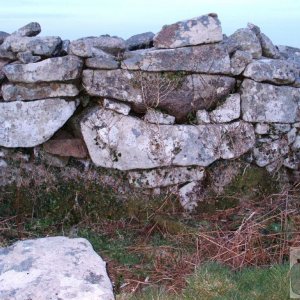
Chun Castle
Like Lescudjack Castle (which was bigger), Chun Castle is a hilltop fortress dating from about 500 BC. It has two stone walls and ditches encircle the summit of the hill. The entrances are staggered to make it harder for the enemy to enter. 'Chun' is a Cornish name derived from 'Chi Woen' or...- trepolpen
- Media item
- chun_castle penwith prehistoric
- Comments: 0
- Album: PENWITH VOLUME ONE: ROMANTIC, ANCIENT WEST CORNWALL
-

Chun Quoit
Like Lanyon Quoit, this was, I understand, once a burial mound with the mortal remains of the cremated skeleton of some chieftain in a bussa or earthenware pot protected by these huge stones. The tombs were long ago ransacked for the chief's golden bracelets or other treasures though such things...- trepolpen
- Media item
- burial chun_quoit cromlech prehistoric
- Comments: 0
- Album: PENWITH VOLUME ONE: ROMANTIC, ANCIENT WEST CORNWALL
-

Boscawen Stone Circle - Sept '06
It was not possible to take a photograph which encompasses the whole stone circle. My wife and I had a timed race round the circle. Pity I can't show you the video clip of me triumphing!- trepolpen
- Media item
- boscawen_un prehistoric stone_circle
- Comments: 0
- Album: PENWITH VOLUME ONE: ROMANTIC, ANCIENT WEST CORNWALL
-
![Lanyon Quoit [framing Ding Dong Mine in distance]](/data/xfmg/thumbnail/14/14195-2265befa1d0ddb81994af34f0b77eb39.jpg?1655646379)
Lanyon Quoit [framing Ding Dong Mine in distance]
As Treeve has previously pointed out in another pic, this quoit (formerly a burial place under a mound of soil) was tall enough to permit a horse rider to pass under without banging his head. I have read that it was lightning that struck it in the early 19th century that reduced its height when...- trepolpen
- Media item
- burial chun_quoit cromlech prehistoric
- Comments: 0
- Album: PENWITH VOLUME ONE: ROMANTIC, ANCIENT WEST CORNWALL
-

Boscawen Stone Circle - Sept '06
A Cornish name (Bosscawenwoen 1319) meaning = Dwelling(Bos) [of] elder trees (scaw) [on the] downs (an woen). The circle is not far from Crows an Wra.- trepolpen
- Media item
- boscawen_un prehistoric stone_circle
- Comments: 0
- Album: PENWITH VOLUME ONE: ROMANTIC, ANCIENT WEST CORNWALL
-

Boscawen Un Stone Circle - Leaning centre stone
Presumably this stone was intended to lean though this is not certain, I believe. People talk of their having been constructed to harness some sort of poorly-understood powers such as the sun or the interconnecting circuitry of ley lines between ancient monuments, but this is beyond my...- trepolpen
- Media item
- boscawen_un prehistoric stone_circle
- Comments: 1
- Album: PENWITH VOLUME ONE: ROMANTIC, ANCIENT WEST CORNWALL
-

Boscawen Un Stone Circle
A Cornish name (Bosscawenwoen 1319) meaning = Dwelling(Bos) [of] elder trees (scaw) [on the] downs (an woen). Someone ('new age' worshipper with Christian leanings?) has evidently placed a gift for Mother Earth under the inclined centre stone of this stone circle.- trepolpen
- Media item
- boscawen_un prehistoric stone_circle
- Comments: 0
- Album: PENWITH VOLUME ONE: ROMANTIC, ANCIENT WEST CORNWALL
-

Boscawen Un Stone Circle
Sun worshipper! This stone circle bears a Cornish name (Bosscawenwoen 1319) meaning = Dwelling (Bos) [of] elder trees (scaw) [on the] downs (an woen).- trepolpen
- Media item
- boscawen_un prehistoric stone_circle
- Comments: 0
- Album: PENWITH VOLUME ONE: ROMANTIC, ANCIENT WEST CORNWALL

